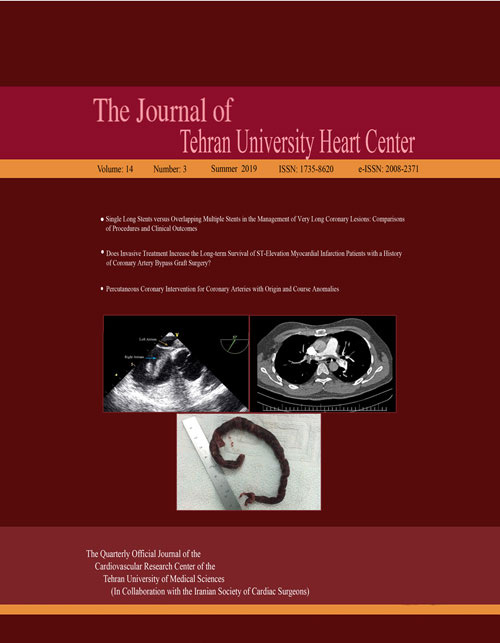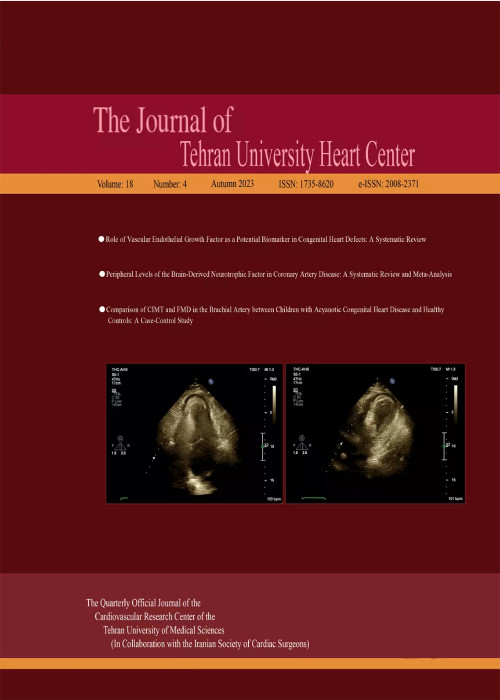فهرست مطالب

The Journal of Tehran University Heart Center
Volume:14 Issue: 4, Oct 2019
- تاریخ انتشار: 1398/04/25
- تعداد عناوین: 11
-
-
Pages 150-155Background
Studies on the association between the prothrombin G20210A variant and coronary artery disease (CAD) risk are inconclusive. This study aimed to investigate the possible association between the G20210A variant in the prothrombin gene and documented CAD and its severity.
MethodsThis study enrolled 1460 patients who were consecutively admitted for elective coronary angiography. Via the standard angiographic techniques, coronary angiographies were done and the presence and severity of CAD were determined through the clinical vessel score and the Gensini score. Prothrombin G20210A genotypes were identified using PCR-RFLP.
ResultsThis cross-sectional study was performed on 953 men and 507 women at a mean age of 58.21±10.33 years. The median and the interquartile range for the Gensini score were not statistically significantly different between the wild (GG) and mutant (AA+GA) genotypes (P=0.440). The association between the G20210A polymorphism and the severity of CAD with respect to the vessel score also showed no significant linear trend of higher numbers of diseased vessels (P= 0.765 for the Mantel–Haenszel test of linear trend) in the AA+GA genotype as compared with the GG genotype.
ConclusionOur data failed to confirm the hypothesis that the G20210A variant mutation may be a significant determinant of CAD risk or its severity.
Keywords: Coronary artery disease, Prothrombin, Coronary angiography, Single-nucleotide polymorphism -
Pages 156-164Background
Although serum paraoxonase-1 (PON-1) and arylesterase (ARE) activities are linked to the presence of stable coronary arterial disease, their correlation with SYNTAX Score I (SS1) and SYNTAX Score II (SS2) has not been known well. Our aim was to determine the association between PON-1 and ARE activities, together with the genetic polymorphism of PON-1, and both SS1 and SS2 in patients with acute ST-segment elevation myocardial infarction (STEMI).
MethodsConsecutive patients with acute STEMI (n=102: 78 male, 24 female; mean age=61.14±12.25 y) admitted to the Emergency Department of Kırşehir Ahi Evran University Hospital between August 2018 and December 2018 were enrolled. PON-1 and ARE activities were determined on hospital admission. The SS1 and SS2 scores were calculated by using the angiographic and clinical data. Subsequently, the relationships between the activities of the enzymes, together with the genetic polymorphism of PON-1, and both SS1 and SS2 were interrogated.
ResultsThe mean SS1 and the mean SS2 were 19.8±9.7 and 32.3±11.5, respectively. The phenotype distributions of PON-1 were Q192Q (n=60), R192Q (n=35), and R192R (n=7). The respective PON-1 (U/L) and ARE (kU/L) activities were 514.85±29.34 and 216.82±36.72 in the low SS1 category; 527.60±56.31 and 203.95±55.97 in the intermediate SS1 category; and, 690.10±11.07 and 238.48±45.65 in the high SS1 category.PON-1 and ARE activities did not correlate with the SS1 categories, and varying SS2 scores. The distribution of the Q192R polymorphism was homogenous among the different SS1 and SS2 scores. The localization of acute STEMI also did not associate with the activities of either enzyme.
ConclusionAdmission serum PON-1 and ARE activities, together with the PON-1 Q192R genetic polymorphism, showed association neither with SS1 and SS2 nor with the localization of infarction in our acute STEMI patients.
Keywords: Myocardial infarction, ST elevation myocardial infarction, Clinical enzyme tests, Arylesterase -
Pages 165-170Background
Orthostatic hypotension (OH) in the elderly is an important health challenge that poses a significant burden. We sought to determine the prevalence and correlates of OH in an elderly population-based study.
MethodsThis study was conducted within the framework of the Amirkola Health and Ageing Project (AHAP) on 1,588 elderly individuals aged ≥60 years. The baseline measurement was performed from April 2011 to July 2012. The relationships between OH (dependent variable) and age, sex, diabetes, hypertension, and cognitive status (independent variables) were investigated by logistic regression.
ResultsThe mean age of the participants was 69.37±7.42 years (men: 69.96±7.68 y, women: 68.66±7.02 y). The prevalence of OH was 10.7%: 8.4% in the male and 13.7% in the female patients. In the final model, hypertension (OR=2.4, 95% CI: 1.6–3.7), diabetes (OR=1.3, 95% CI: 1.0–1.9), age (OR=2.9, 95% CI: 1.7–4.8), and female sex (female [OR=1.6, 95% CI: 1.1–2.3]) were significantly correlated with OH.
ConclusionThe prevalence of OH in our elderly subjects increased with age. Additionally, the older participants with diabetes and hypertension had a higher likelihood of having this OH.
Keywords: Hypotension, orthostatic, Aged, Prevalence -
Pages 171-176Background
The aim of this study was to investigate the ability of a new index, namely the left ventricular internal dimension at end-diastole/mitral valve E-point septal separation (LVIDd/EPSS), to predict the left ventricular (LV) systolic function and to compare its performance with that of the EPSS index and to investigate the correlation between the LVIDd/EPSS and the left ventricular ejection fraction (LVEF).
MethodsThe current study recruited 142 patients who presented to the Cardiology Clinic of Sakarya University Education and Research Hospital and were followed for heart failure (HF).M-mode measurements of the EPSS and the LVIDd were recorded in the parasternal long-axis view.
ResultsTotally, 142 HF patients with midrange ejection fraction (HFmrEF) and reduced ejection fraction (HFrEF) were enrolled in the study. There was a significantly correlation both between the EF and the EPSS and between the EF and the LVIDd/EPSS (P<0.001). In both HFmrEF and HFrEF groups, the correlation between the LVIDd/EPSS and the EF was more significant than was the correlation between the EPSS and the EF (P<0.001). The results of the linear regression analysis indicated that the LVIDd/EPSS was an independent predictor of the HFmrEF and the HFrEF (P<0.001). In the patients with EPSS≤12, there was a significant association between the EF and the LVIDd/EPSS (P<0.001) but not between the EF and the EPSS(P>0.05). The receiver operating characteristic curve analysis showed that the LVIDd/EPSS predicted advanced HF with 87% sensitivity and 72% specificity, using a cutoff value of 3.35,and it predicted the HFrEF (EF<40%) with 84% sensitivity and 81% specificity, using a cutoff value of 3.75.
ConclusionThe LVIDd/EPSS may allow certain clinicians, especially beginners and emergency department physicians, to assess the LVEF when other methods are not available or questionable .
Keywords: Heart Ventricles, Ventricular function, left, Heart failure -
Pages 177-182Background
Ischemic postconditioning is a novel strategy for attaining cardioprotection. Remarkable evidence from various in vitro and in vivo animal and human studies have shown significant opioid-induced cardioprotection against myocardial ischemia/reperfusion (I/R) injury. The purpose of this study was to assess the cardioprotective effect of sufentanil against I/R injury after on-pump coronary artery bypass grafting (CABG).
MethodsBetween June 2016 and July 2017, 80 consecutive patients with triple-vessel disease undergoing on-pump CABG were enrolled in this prospective randomized study. The patients assigned to the sufentanil group received a single dose of sufentanil (0.2 μg/kg diluted with 50 cc of saline) 5 minutes before the removal of the aorta cross-clamp, with the sufentanil injected via a cardioplegia needle into the aortic root. In the control group, the same volume of normal saline was injected as a placebo. Cardiac enzymes, the inotrope score, and the outcome data were compared between the 2 groups.
ResultsThe mean age of the patients was 60.48±7.50 years (range=41–69 y), and men comprised 65.0% of the study population. The levels of CK-MB and cardiac troponin I were significantly lower in the sufentanil group (P<0.001). The amount of inotrope use (P<0.001), the incidence of atrial fibrillation (P=0.014), electrical shock (P=0.007), and the mechanical ventilation time (P<0.001) decreased in the sufentanil group compared with the control group. However, the use of intra-aortic balloon pumps (P=0.247) and the ICU length of stay (P=0.867) were not significantly different between the 2 groups.
ConclusionThe injection of a single dose of sufentanil into the aortic root prior to aorta cross-clamp removal diminished cardiac injury during on-pump CABG in our patients.
Keywords: Cardiopulmonary bypass, Cardiac surgical procedures, Sufentanil, Ischemic postconditioning, Reperfusion injury -
Pages 183-186
Apixaban was introduced in clinical use for nonvalvular atrial fibrillation as an alternative to warfarin. There is a dearth of information regarding apixaban use in patients suffering from atrial fibrillation with intracardiac foreign bodies such as pacemaker leads. In this report, we describe a 72-year-old female patient with a complaint of weakness in both legs of a few days’ duration. She was detected to have a thrombus over the pacemaker lead and inside the left atrial appendage during apixaban treatment. After the discontinuation of apixaban and the commencement of warfarin, the thrombus was resolved. Our case is the first report to show that apixaban treatment (5 mg, twice daily) may not prevent the development of pacemaker lead thrombosis in patients with atrial fibrillation.
Keywords: Apixaban, Pacemaker, artificial, Thrombosis, Atrial fibrillation -
Pages 187-190
In the majority of patients undergoing transcatheter aortic valve implantation, the transfemoral access is the suggested approach due to its less invasive nature and feasibility in patients with suitable vascular anatomy. The complications of the transfemoral access site are generally vascular; however, we herein present a rare case of colon perforation following the transfemoral procedure owing to prior abdominal surgery. A transfemoral aortic valve was inserted on account of severe aortic stenosis and a high probability of surgical mortality. The patient developed acute abdomen following the procedure. Hemicolectomy was performed because of colonic perforation caused by femoral catheterization. The patient was well at 3 months’ follow-up.
Keywords: Transcatheter aortic valve replacement, Intestinal perforation, Colectomy -
Pages 191-194
Many complications may ensue coronary bypass surgery. Among these complications, early or late dissection of the ascending aorta is a very rare condition. Successful surgery without life-threatening results can save lives. In this case report, we present a case of aortic dissection due to cross-clamp injury in a patient who underwent coronary artery bypass surgery. A 60-year-old female patient underwent double-vessel aortocoronary bypass surgery due to coronary artery disease. After distal bypasses were performed and the cross-clamp was removed, dissection of the aorta occurred. Consequently, axillary cannulation and ascending aortic replacement with a prosthetic graft were performed via the open technique. The saphenous vein graft was sutured to the aortic prosthetic graft, and cardiopulmonary bypass was terminated after hemodynamic stability was achieved. The patient was discharged on the 10th postoperative day, and she has been followed up for 2 years after surgery without any problems.
Keywords: Coronary artery bypass, Aneurysm, dissecting, Aorta -
Page 199


